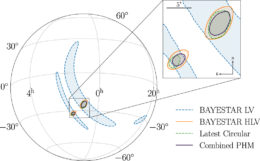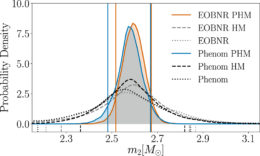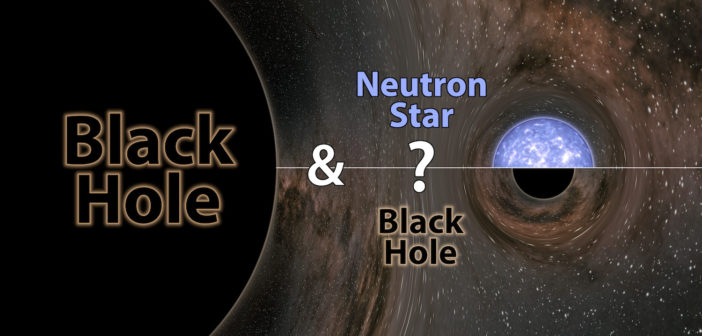Neutron star or black hole? That’s the question scientists are asking about the latest gravitational-wave detection announced from the Laser Interferometer Gravitational-wave Observatory (LIGO) and its sister observatory, Virgo. In a new publication, scientists detail this newest addition to the list of confirmed collisions — and explain why it’s rather unexpected.

Artist’s impression of two merging neutron stars. [National Science Foundation/LIGO/Sonoma State University/A. Simonnet]
Still More from O3
Things have been decidedly quiet on the LIGO-Virgo front lately. The gravitational-wave detectors’ third observing run, O3, wrapped up in March (cut unfortunately short due to COVID-19). Since then, the collaboration has announced only two discoveries from this run: another binary neutron star merger, and the collision of two black holes of very unequal masses.
Yet there remain many dozens of potential candidates recorded during O3 that are still undergoing analysis to confirm whether they’re “true” detections — and, if they are, to identify the properties and astrophysical implications of the mergers.

Despite GW190814’s relatively small sky localization (shown here), no associated electromagnetic signature was found — but we also wouldn’t expect one from such an unequal-mass binary, as the secondary would likely have been swallowed whole. [Abbott et al. 2020]
Thwarting Expectations
GW190814 was detected in August of last year by all three of the LIGO-Virgo detectors. The signal was localized to a region of just 18.5 square degrees, but follow-up observations didn’t detect any corresponding electromagnetic signatures from the area. Despite the lack of fireworks, however, GW190814 is anything but mundane — in fact, it’s a source unlike any other known compact binary merger.
What makes GW190814 so weird? There are three main factors:
- Very unequal masses
The two objects that collided to produce GW190814 had a mass ratio of q = 0.112. This is the most unequal mass ratio yet measured in a merger; most mergers consist of two objects that are nearly the same mass. - Low primary spin

The mass gap between the heaviest neutron stars and the lightest black holes is clearly visible in this diagram of the masses of known compact binary components, compiled at the end of 2018. [LIGO-Virgo/Frank Elavsky/Northwestern]
The primary object in the binary, the 23-solar-mass black hole, has an extremely low measured spin of χ1 ≤ 0.07. This is the tightest constraint we’ve ever placed on the spin of the primary component of a gravitational-wave source. - Mass-gap secondary
The secondary object in the binary, the 2.6-solar-mass body, falls right in the middle of what’s known as the mass gap: its mass is heavier than the heaviest confirmed neutron star (~2.5 solar masses), but lighter than the lightest confirmed black hole (~5 solar masses). So which is it: a neutron star or a black hole?

The marginalized posterior distribution describing the likely mass of the secondary object, for different waveform models. The 90% credible range is 2.50–2.67 solar masses, which lies firmly in the mass gap. [Abbott et al. 2020]
A Challenge to the Paradigm
Regardless of whether this unusual merger occurred between two black holes or between a black hole and a neutron star, GW190814 challenges our current models of compact binaries and their components.
How could a binary containing such a heavy black-hole primary and such a light neutron-star or black-hole secondary form? And what about the perceived mass gap between neutron stars and black holes — is it real? Or is it just an observing bias?
We have a lot of questions, and a lot of work to do to account for GW190814 in our theoretical models. But if GW190814 does, indeed, represent a whole new kind of compact binary merger, then we also have an exciting road ahead as LIGO-Virgo inevitably discovers more of them, allowing us to gradually piece together the puzzle of these unexpected collisions.
Citation
“GW190814: Gravitational Waves from the Coalescence of a 23 Solar Mass Black Hole with a 2.6 Solar Mass Compact Object,” R. Abbott et al 2020 ApJL 896 L44. doi:10.3847/2041-8213/ab960f

3 Comments
Pingback: Gravitational Waves Shed Light on How Heavy a Neutron Star Can Be
Pingback: From AAS NOVA: “Gravitational Waves Shed Light on How Heavy a Neutron Star Can Be” | sciencesprings
Pingback: Gravitational waves shed light on maximum neutron star mass